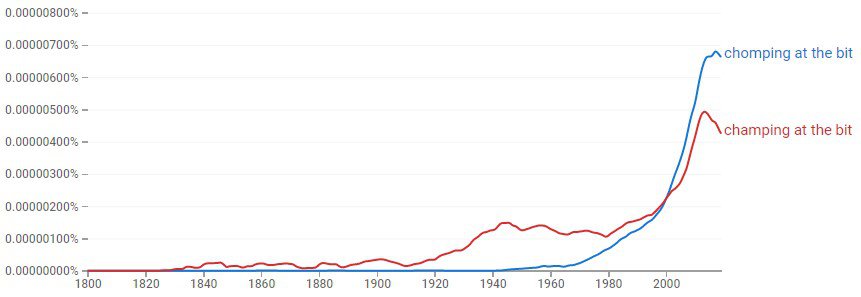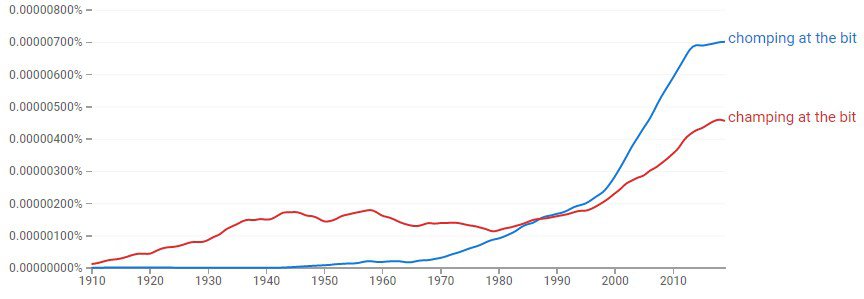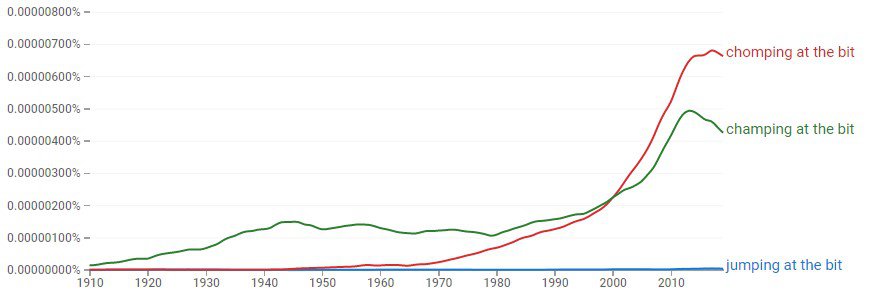Is it chomping at the bit or champing at the bit? Technically, both are correct, but they have different histories. While champing at the bit came first, chomping at the bit has also been in the linguistic mix for over a century and is widely accepted today.
The meaning of this idiom is to highlight the impatience of someone. Champing (or chomping) at the bit was first used to explain the imagery of a restless horse grinding its teeth against its bit (part of the bridle) when being held under control. Fast forward to today, the expression highlights a person’s impatience to get something done or to get moving.
Idioms are words or phrases that have literal origins, but over time, they’ve taken on a more figurative meaning. They are excellent ways to improve your grammar through analogy and metaphor, and their use indicates a connection between a literal event and a modern context to add detail and interest to your sentences.
Dive deeper below to explore this idiom in its entirety: its history, the acceptance of both spellings, and handy examples to incorporate it seamlessly into your conversations and writings.
Word Origin
Champ vs. chomp: both are a verb you may have heard interchangeably within this not-so-common phrase.
Champing stems from an old Middle English word that has been around for at least 600 years and relates to the grinding of a horse’s teeth. Most likely imitative in nature, the word has been more modernly used to express the biting down upon a bridle bit as a horse is held in restraint – thus highlighting the animal’s restless behavior and impatience to be off (especially in horse racing).
The bit is the piece of iron held within a horse’s mouth, between the teeth and over the tongue to help provide control and direction with proper rider use.
The catch is, the word champing is more or less non-existent in contemporary English despite its more popular use (more on that later), and unless you work closely with horses or in the horse racing industry, chances are you’ve never heard it used as champing at the bit. Replace champing with chomping, and now you have a more familiar term – which is why you may want to use it in this manner.
History of the Idiom
To chomp at the bit is an idiom or phrase that has more of a meaning than the individual words being used. Obviously, as explained above, the expression is commonly used to express the need for one to be impatiently waiting, such as a horse at the bit.
Originally coined in the book “Joseph: A Religious Poem” written by Charles Lucas and published in 1810, it appeared in the well-used, original form: champing. By 1910 it was referenced as “chomping” in The Decatur Daily Review in reference to horse racing, and the rest seems to be history.
The word chomping is certainly a more acceptable use to many of our ears, but despite that, champing is actually the more popular use. It is important to note, however, that the phrase isn’t widely used in modern vernacular.
Popularity
Although you may have never heard of the word champ before now, surprisingly enough it is a more common use within the phrase as noted above. The reasoning behind this may simply be that the phrase is not that popular overall.
Chomp is more common with American English speakers compared to British use, but both American and British English have traditionally put the word champ to use more often despite a falling off of the overall phrase through the 20th Century.
Examples
Both forms are easy to find in edited publications and blogs from throughout the English-speaking world—for example:As for drama (or tragicomedy, to be more precise) I am champing at the bit for “Waiting for Godot.” [Los Angeles Times]
He was chomping at the bit to get on with implementing his magnificent suite of policies. [Herald Sun]
Another driver who’s champing at the bit to get into action is former V8 champion Booth. [New Zealand Herald]
What About Jumping at the Bit?
You may also have heard the phrase “jumping at the bit” used as a substitution for either champing or chomping. The issue with using the word jumping is that when taken literally it describes an action verb that makes no sense in combination with the word bit. One may visualize a horse jumping towards or over an obstacle to get closer to a bit – which is absolutely absurd.
This substitution came into use in the early 1900s, most likely by those unfamiliar with what a bit actually was. Although it pops into use every now and then, compared to the use of both champing and chomping – it is practically non-existent. Therefore, we do not suggest its use.
The Bottom Line
The original, and proper use of the term is champing at the bit, and it also is surprisingly more widely used even though chomping at the bit may seem more familiar to the majority of our readers. Regardless, both are acceptable to use even if one is technically more correct. If you have been concerned about using it incorrectly, have no fear, you are fine either way – unless you are a stickler for proper word usage related to original idiom. Let us know what you think below and as always, please share!




